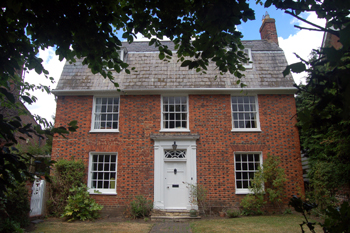Tilcocks Aspley Guise
![Tilcocks as Aspley Guise Post Office about 1890 [Z818/11]](/CommunityHistories/AspleyGuise/AspleyGuiseImages/Tilcocks as Aspley Guise Post Office about 1890 [Z_351x292.jpg)
Tilcocks as Aspley Guise Post Office about 1890 [Z818/11]
Tilcocks was listed by the former Ministry of Works in January 1961 as Grade II, of special interest. The ministry dated the house to the later 18th century. It is built of red brick with a chequered pattern in vitrified headers. It has a slated mansard roof.
Local historian Arthur Parker had access to the deeds of Tilcocks, as well as Ivy and Lime Cottages, How Cottage and Saint Christopher and the Courtney Memorial Hall [CRT130Asp19]. The earliest reference he could find to Tilcocks was in the will of John Battams of 1818, where he devised it to Mary Timms his daughter, wife of Thomas Timms of Husborne Crawley, victualler. Battams died in 1820. In 1821 the property was sold by auction and bought by George Bird of Aspley Guise, gentleman for £300. He later purchased an adjoining half acre from Richard Thomas How in 1826.
In 1844 Bird devised the property to Gregory Bird and William Cole, executors, for the life of his widow Mary Anne for her life, afer which it was to be sold and the proceeds dispersed among their children. The will was proved in1848. In 1872 William Cole conveyed Tilcocks to George Mason Bird. In 1889 Bird's executor John Fenn Cole conveyed the house to Henry Paul Harris of Whitechapel [Middlesex], merchant for £550. In the same year he purchased How Cottage, Saint Christopher and the former British School. The building served as the village post office until May 1916 when the office moved to a three storeyed building in Church Street.
The Rating and Valuation Act 1925 specified that every building and piece of land in the country was to be assessed as to its rateable value. Aspley Guise was assessed in 1927. The valuer visiting Tilcocks found it was then called Saint Andrew's Lodge. It was owned by Alfred R. Sinfield of Ivy Cottage, and in the occupation of Arthur E. P. Voules who paid £32 per annum in rent [DV1/C239/134]. The valuer commented: "Sinfield has only just bought property". Kelly's Directories for Bedfordshire list Saint Andrew's Lodge from 1920 when Arthur Voules was already in residence. The directories for 1936 and 1940 list Miss Sargeaunt, who had been at Lime Cottage in 1927, in residence.
The brick and slate detached property comprised three reception rooms, a kitchen, scullery and larder downstairs with two bedrooms, a w. c. and a dressing room above and two attics above that. Outside stood a brick and tile stable and coachhouse. The valuer commented: "Was post office" and noted that mains water, drainage and gas were all laid on.
For some years Tilcocks accommodated Aspley Guise post office in the front garden, as the photograph at the head of the page shows. Directories first record a postmaster, John Shemeld, in Aspley Guise in 1869. Neither the man nor the occupation are listed in the 1861 census but Shemeld is listed in 1871. The census return indicates that he was 70 years old and had been born in Woburn, his wife Sarah, aged 66, was from Cranfield. The census return places his entry next to that of George Goodman, baker, in The Square.
Given Shemeld's age it is unsurprising to find that in a directory of 1877 Harry Clarke is listed as postmaster; interestingly he was also a photographer and may be responsible for some of the earliest photographs of The Square and surrounding area. He is listed as postmaster in the 1881 census, but here his other occupation is listed as painter. He was just 30 years old at the time and came from Woburn, his wife, Maria, aged 31, being an Aspley girl. The census places him in Church Street.
A directory of 1885 lists the postmaster as Sydney James Chisnall; interestingly he was listed by the 1881 census as living next to Harry Clarke. He was a saddler, a business he continued in after becoming postmaster. He was 35 in 1881 and came from Potsgrove, his 35 year old wife, Mary, being from Lidlington. Interestingly they had two lodgers from Worcestershire staying with them at the time, aged 20 and 21 respectively and both printers and compositors and no doubt both working at John Kemp & Company or, as it later became, Powage Press. Chisnall remained the postmaster until at least the outbreak of the First World War and it seems likely that it was during his post mastership that the office was in the garden of Tilcocks. From at least 1920 Alice Holmes was postmistress at what is now the Old Post Office in Church Street.
 Tilcocks July 2010
Tilcocks July 2010